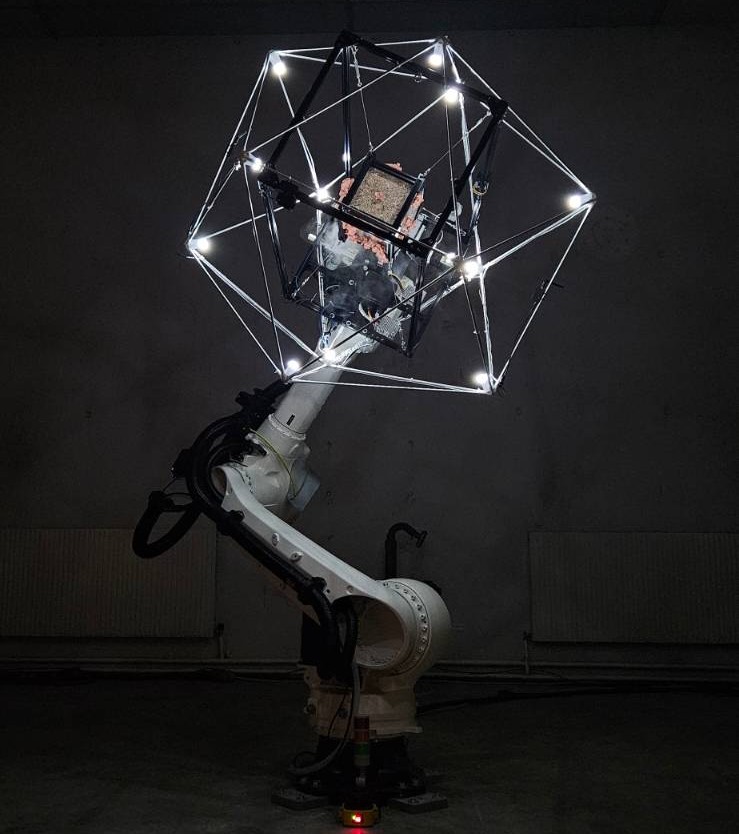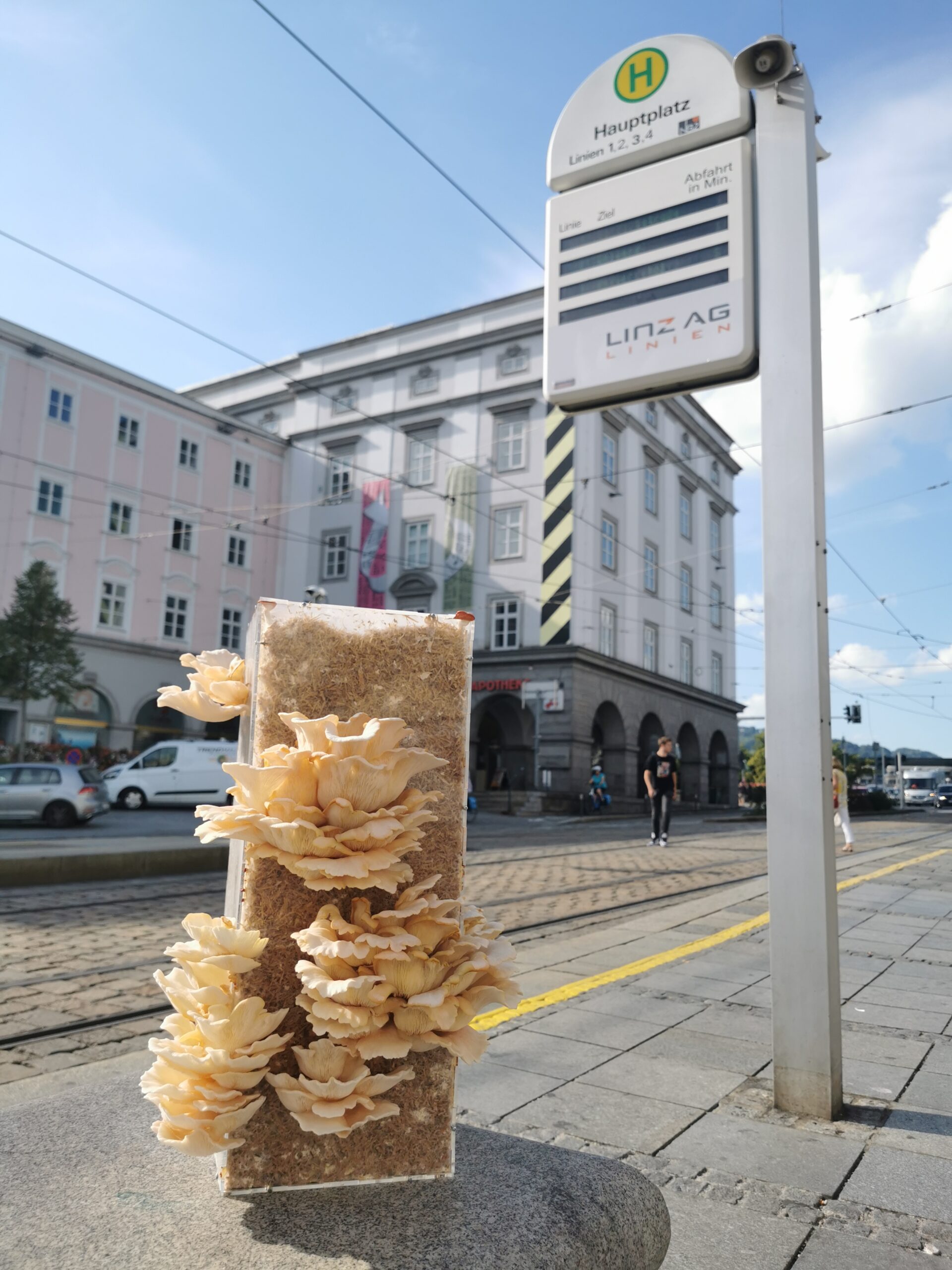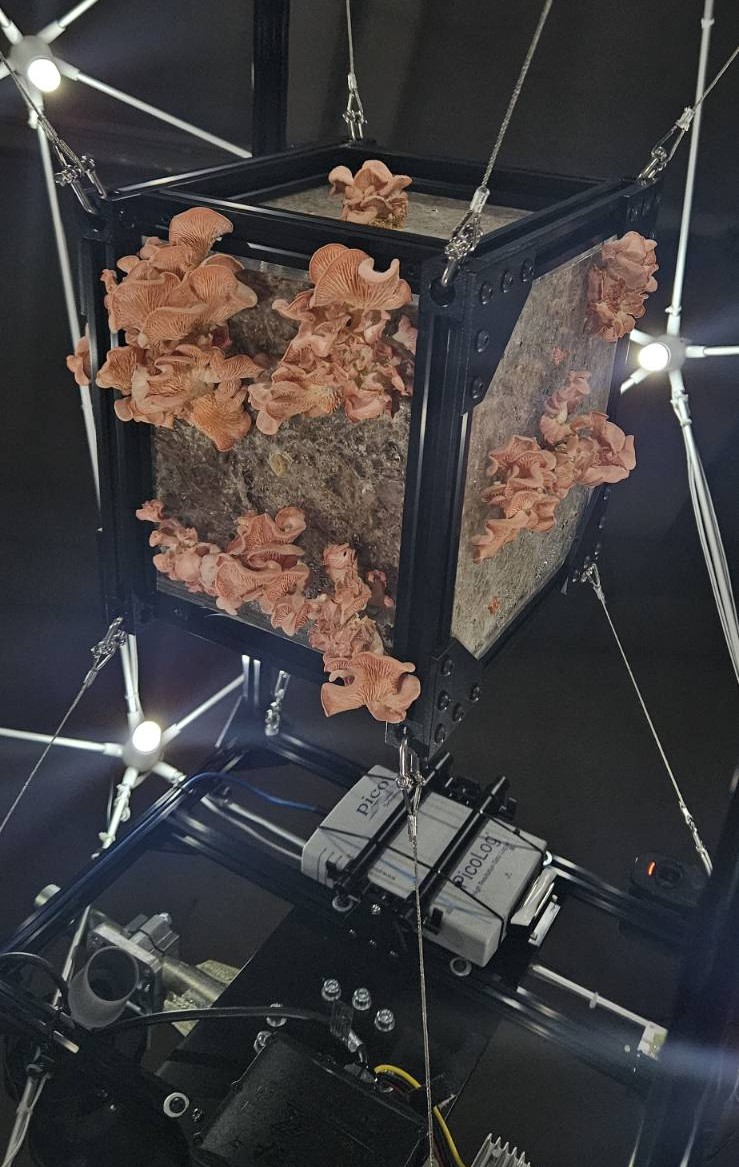
MycoGravity

Amir Bastan, Noor Stenfert Kroese, Johannes Braumann
In simple terms
All organisms that grow on Earth are shaped by gravity. Mushrooms sense it and usually grow with the thin stripes under their caps facing downwards, as you can see in the picture. In MycoGravity, a robotic arm keeps turning a growth chamber with mushrooms so gravity never points in one direction for long. This creates altered gravity, unlike the constant gravity that shapes life on Earth. We explore how mushrooms adapt to this shifting orientation, observing how life may change when one of its most basic conditions is altered.

(Pleurotus djamor)

(Setup phase)
Full FAQ
What is MycoGravity?
MycoGravity is a robotic installation and artistic research project that explores fungal growth under altered gravitational conditions. It is part of a continuing series of works including RHIZA and ZOE that investigate how fungi, sensing systems, and robotics can form new environments of interaction.
In a custom-built bioreactor mounted on a KUKA Iontec K30R2100 robotic arm pink oyster mushrooms develop while the robot simulates unstable gravity through programmed movement inspired by NASA’s random positioning machines. Sensors and cameras track environmental conditions and fungal activity over time. The mushrooms that emerge become sculptural forms shaped by this shifting environment, later dried and preserved as physical recordings of their adaptation. The installation explores how terrestrial life might respond, delicately and unexpectedly, to unfamiliar environments.
How does MycoGravity simulate altered gravity?
The KUKA robotic arm moves the bioreactor through a quantised random walk, selecting defined points in three-dimensional space and rotating across multiple axes as it transitions between them. This creates constant, unpredictable motion, inspired by NASA’s random positioning machines.
The principle behind this is known as vector averaging: the gravitational vector is continuously reoriented so that it never remains stable in one direction long enough for the fungi to align themselves. Although gravity is not eliminated, its effect is averaged out over time. The result resembles conditions of microgravity or partial gravity. The effect does not depend on speed, even slow, multi-axial rotations are enough to disrupt the organisms’ gravitropic sensing.
Simply said: the robot keeps turning the fungi in so many directions that gravity never points the same way for long, so the mushrooms can’t figure out which way is “up.”
What are the main components of MycoGravity?
The MycoGravity system consists of three main components: a robotic arm, a bioreactor, and a local server. At its core is the KUKA Iontec K30R2100, a six-axis industrial robotic arm. Attached to its end is a custom-built, geometrically designed bioreactor that holds the box with pink oyster mycelium.
Inside the bioreactor is a mycelium chamber where the fungi grow. Subdermal needle electrodes are embedded in the mycelium to record bioelectric signals. In the outer layer, the bioreactor houses sensors for temperature, humidity, CO₂, light, and motion (IMU), a humidifier, grow lights, camera’s, a PICO24 high-resolution data logger and .
All these devices collect environmental and physiological data in real time. This data is sent via a dedicated Wi-Fi access point to an external local server. The system uses this data to adjust both the robot’s movement and the environmental conditions. This complete setup is what we refer to as the robotic system.
What is mycelium, and what are these signals?
Mycelium is the main body of a fungus a dense, thread-like network that grows through materials like soil or wood. It plays an important role in breaking things down and keeping ecosystems alive. The mushroom or fruiting body is just a temporary part, like a flower to a plant, used for reproduction.
Mycelium exchanges very small electrical signals through its network. These signals are being researched as a way to better understand how fungi interact with their surroundings how they sense, adapt, and possibly even make decisions. Researchers are exploring whether these signals could be used for environmental sensing, sensing systems embedded in soil, architecture or other materials and biocomputing.
What kind of fungi are growing here?
We are working with Pleurotus djamor also known as pink oyster mushrooms. They are fast-growing, edible, non-toxic, and safe to exhibit. This species was chosen because the conditions of this exhibition are well suited to its needs. In other contexts, we might use a different oyster mushroom species, as we always choose them based on the specific environment and location the installation is shown in.
Why use fungi for this?
Fungi are sensitive to gravity and use it to guide their growth, this is called gravitropism. However, how they sense and respond to gravity is still largely unknown. By exposing them to a constantly shifting orientation, MycoGravity gives us a way to observe how they might adapt, or struggle to adapt, in the absence of a clear gravitational direction.
Why don’t I see mushrooms right now?
This is a living artwork, and its state changes over time. Sometimes you may see visible mushrooms (fruiting bodies), and sometimes only the mycelium is active inside the bioreactor. We observe both the mycelium and the mushrooms, as part of the organism’s response to its environment. The installation continues to function and generate data even when no fruiting bodies are visible. What you see depends on when you visit.
What happens to the mushrooms after the exhibition?
They are not harvested or eaten. Instead, the mushrooms are kept as dried sculptures, a physical record of how they responded to unfamiliar forces. The mycelium may produce a few more flushes of mushrooms after the exhibition. After that, it’s composted.
Are you trying to grow mushrooms in space?
Not directly. But MycoGravity is inspired by space research and the idea of astromycology (the study of fungi in space). It explores how life might behave when the stable conditions we’re used to, like gravity, are no longer present.
Are fungi or robots going to take over the world?
Unlikely
Is this installation safe?
Yes. The robot is equipped with an active safety system that uses two zones. In Zone 1, if someone enters, the robot slows down while an orange and red warning light flashes beneath it and a sound signal is triggered. If the person steps back into the safe zone, the installation automatically recovers and continues. In Zone 2, if someone crosses it, the robot stops immediately and a red light signals the emergency stop.
What kind of research is this part of?
MycoGravity is part of the ongoing Mycobotics research at Creative Robotics which explores how fungi, robots, and humans can interact through parallel, asynchronous, and context-driven processes. Rather than relying on direct input–output feedback, it examines how autonomous agents influence one another indirectly through shared environmental conditions. It explores whether fungal mycelium through its sensing properties and electrical activity can function as an active component in real-time robotic systems. The project aims to establish experimental systems in which living organisms and machines operate as co-constitutive agents within responsive environments of sensing, adaptation, and interaction.
Who developed MycoGravity?
The project was created by Amir Bastan, Noor Stenfert Kroese, and Johannes Braumann at the Creative Robotics, University of Arts Linz. It builds on their earlier work with fungi, sensing systems, and real-time robotic installations. With the generous support of KUKA DACH and Mushroom Research Center Austria.